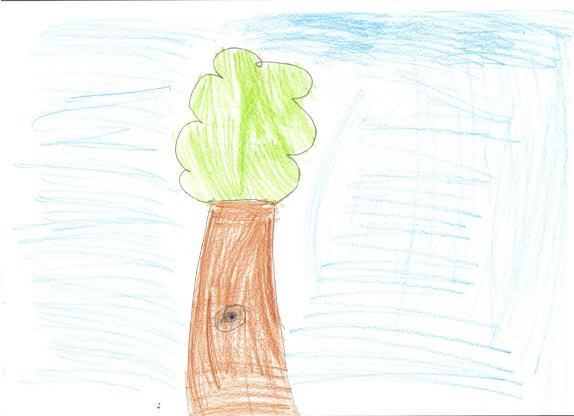Karl Koch's Tree Test
Karl Koch's tree test to interpret personality

Karl Koch's Tree Test is a projective psychological test to analyze people's personality and the underlying emotional universe. Given the ease of its application, it is commonly administered to children. However, it is also a useful self-analysis tool for adults, as it helps to get to know each other a little better.
This test, also known as "Baumtest", was developed by psychologist Charles Koch in the 1950s. It would be reductive to say that the test is simply asking a child or an adult to draw a tree with roots, trunk and crowns, many readers would doubt the reliability and validity of this evaluation tool.
One of the advantages of the tree test is that it can be assigned to a wide variety of people. It offers interesting information about certain emotional aspects which are then compared with the results of other tests.
Before reaching this conclusion, it is worth considering some issues. Projective tests are a very useful clinical tool for understanding how patients perceive, understand and manage their world. Together with the Rorschach test and the person's design in the rain, the tree test is a very effective and complementary test (not exclusive, therefore) to many others.
In addition, Dr. Koch chose the tree figure for this diagnostic test because of its symbology. In all cultures and countries trees have always had mythological and totemic references. Trying to shape them, to draw them, is like trying to bring out the lights and shadows that are inside us.

What does the Koch Tree Test evaluate?
Karl Koch's tree test, like any other exercise that invites you to make a drawing, choose colors, create a figure from scratch on a white sheet, gives some clues about our personality. It also denotes a certain emotional state.
- It also measures the stability of a person, the presence or not of inner conflicts, vulnerability and sensitivity.
- On the other hand, certain psychological currents, such as psychoanalysis, claim that this test also reveals the structure of the psyche or the content of our unconscious.
- According to a recent study, the tree test was very effective in diagnosing cognitive disabilities or even dementia principles.
How do I run the test?
This test can be assigned to anyone from the age of 5 or 6 years. Certain basic motor skills involved in the design process are required.
- The person is given white sheets, colored pencils and a eraser to erase.
- You are asked to draw a tree with roots, trunk, branches, etc.
- Children aged 5 or 6 years are asked to make two drawings. The first, a free drawing:"Draw the tree you want, one you like". The second drawing must be a tree different from the first one. In this sense, two drawings allow a more precise assessment to be made.
- The test time is 10 to 30 minutes, depending on the person.

How do you analyze the Karl Koch tree test?
A number of elements must be taken into account:
Land
- A design in which the line of the ground or roots is missing may indicate a lack of emotional and personal stability.
- Proportional roots in the form of rays and disproportionate roots may suggest problems of emotional repression, anger and instability.
Trunk
- A very thin trunk is associated with very sensitive and delicate people or may suggest the presence of external tensions or demands that alter their calm and well-being.
- A very large trunk indicates impulsiveness, high emotion and low self-control capacity.
- A trunk formed by straight lines denotes precision and great abstraction capacity.
- A trunk with wavy lines indicates a great capacity for socialization and sweetness.
- Trunks with irregularities, stains, blemishes, voids, tips indicate the presence of fears, traumas, repressed emotions, inhibition.
Chioma
The canopy of the tree reflects the interaction with the physical and external world. While the trunk and roots associate more with the inner and emotional world, the branches represent a different psychic level.
- Narrow foliage: up to 9 years old, children always draw a small, narrow foliage. It is normal, it denotes immaturity and a link with the childish world.
- Large foliage: it can suggest that the person is endowed with great imagination, enthusiasm or may have some characteristics of narcissism.
- A tree without canopy may indicate that the person in question has a possible cognitive development problem.
- Spiral hair: the person has communication skills, good taste and is delicate.
- Chioma in the shape of rays or rods: the person is impulsive, hatching anger or provocative feelings.
- Canopy with leaves: The person is lively.
- Chioma with fruits: the person has goals and desires to achieve.

Karl Koch Tree Testing
To these values are added many others, such as the presence of "accessory" elements, such as houses, birds, hills... In other words, details not requested by the psychologist who can suggest relevant information. Also take into account the colours chosen to draw the tree and the size of the figures.
Elements such as cut branches, holes or grooves in the trunks, lack of roots or the use of dark colours certainly attract attention. All this could suggest the presence of traumas. However, as we anticipated at the beginning of the article, the Karl Koch Tree Test is not used as the only and exclusive diagnostic test. This is a very interesting evaluation tool which, in combination with other equally valuable tools, can provide useful information for a more accurate diagnosis.